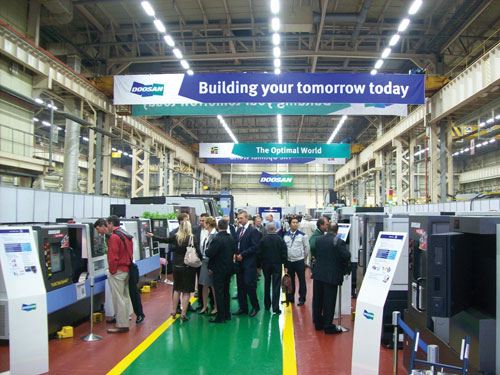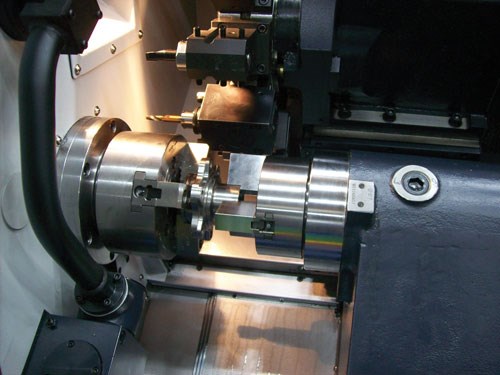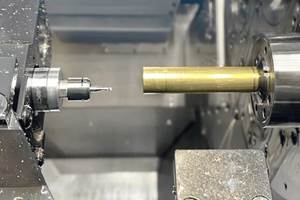The first thing I noticed while perusing the Doosan International Machine Tool Fair (DIMF), machine tool builder Doosan’s in-house technology exhibition in Changwon, South Korea, was the sheer diversity of the company’s product line. Equipment ranged from conventional HMCs and VMCs to turn-mills, massive horizontal boring mills, vertical turning centers, wire EDMs and even Swiss-type lathes. Not all of these machines are available in all markets—for example, the company’s U.S. arm, Doosan Infracore America (Pine Brook, New Jersey), doesn’t offer EDMs or Swiss-types—but the variety of high-end technology on display from a single builder was striking.
For that matter, so was the quantity. The 30,000-square-foot main exhibition area housed a total of 60 machines. Of those, 39 have been introduced within the past year, a number that is greater than, but still on par with, the number of new machines unveiled at previous editions of DIMF. With so many new models to see, it’s no wonder that major dealers from all over the world travel to DIMF every two years to stay up-to-date on the products they sell. Many of these dealers, who hail from countries ranging from nearby China and Japan to Germany, Italy, Brazil and Turkey, to name a few, also bring along their most important customers. Add domestic dealers and customers, and attendance for every DIMF since the event’s inception in 1997 has totaled more than 2,000, the company says. This year’s show, a three-day affair in mid May, was the biggest yet, with 2,700 domestic and 530 foreign visitors.
Despite the diversity of machines on display, walking the show floor revealed that many shared a common trait: design features intended to boost rigidity and power for heavy hogging. In keeping with this trend, larger machines were also prevalent, as were features designed to reduce the effects of heat on the machining process. The following provides brief descriptions of a few notable examples:
“Bread and Butter” of the Turning Line
That’s how one U.S.-based Doosan representative referred to the Puma 2100, 2600 and 3100 series lathes. Available in a variety of sizes with a variety of options, these recently introduced models come standard with 8-, 10- and 12-inch chucks, respectively. Configurations range from simple two-axis lathes to full turning centers equipped with subspindles and Y-axis tool posts for milling capability.
Like all Doosan machines, the lathes’ construction begins with Meehanite castings. However, these machines include a number of additional features that contribute to the rigidity required to withstand heavy or interrupted cuts. Width and thickness of the bed guideways are 25 to 50 percent larger than those of the machines they are designed to replace. Y-axis saddles also feature an increase in width and thickness, as does the mounting area for the spindle and the mounting area for the optional subspindle. Spindle length has been shortened to reduce vibration, and spindle bearing diameters have been increased to improve rigidity.
To reduce adverse effects of heat on the machining process, heat shields and fan motors serve to isolate the machine structure from heat generated during operation. Likewise, bevel gears are cooled via air or oil mist.
Rigidity, Speed Are Not Mutually Exclusive
Like the Pumas described above, the DNM series three- and five-axis VMCs also feature rigid structures. Interestingly, these machines are designed not for heavy cuts, but rather accuracy and high speeds. Nonetheless, the company has determined that working faster does not necessarily translate to working better, and pairing a rigid construction with high speed, high-acceleration drives results in a better overall package.
To that end, these machines feature a C-frame structure with an arch-shaped column. According to the company, this pyramid-style casting evenly distributes weight and limits vibration. Other Doosan VMCs, including the Mynx and VM series, also feature this type of structure.
For temperature control, ballscrew nuts on the DNM series machines are surrounded by cooling jackets. To minimize heat growth in the spindle, heat from the belt is isolated from the rest of the structure and pulled away from the machine using a fan. Meanwhile, an oil circulation system prevents the spindle bearings from overheating and ensures a constant temperature regardless of ambient conditions, the company says.
Energy-Industry Turning
A number of the lathes showcased at DIMF are designed to accommodate heavy cuts and big parts. Notable examples are the the Puma 700LY, the Puma 480LD, and the Puma 800B, all of which were touted as being especially useful for large shaft parts used in oil- and energy-industry applications.
With a standard 21-inch standard chuck and an 24-inch chuck available as an option, the 700LY can accommodate workpieces as long as 3,250 mm with diameters ranging to 750 mm (a larger version, the XLY, can accommodate workpieces as long as 5,050 mm). Y-axis functionality adds to the machine’s flexibility, the company says, while the three-step gear spindle provides a maximum of 6,605 Nm of torque for heavy-duty cutting.
The 480LD also features a high-torque spindle, which is capable of achieving 4,465 Nm. Able to accommodate parts measuring 650 mm in diameter and 2,042 mm long, this model is slightly smaller than the 700LY, but it features a relatively large spindle bore at 275 mm. The Puma 800B features an even larger spindle bore measuring 375 mm.
Large, 50-Taper HMCs
Among the other large machines at the show were two representatives of Doosan’s new NHM and NHP series of HMCs. Similar to the company’s HM and HP series—which they will eventually replace—one of the most significant differences between the two model types is that the NHMs offer linear guideways for high speed and the NHPs offer box guideways for heavy cutting. However, unlike the previous HM and HP machines, the 50-taper NHM and NHP machines share the same structural design as well as many of the same components and accessories. Sharing common machine tables, ATCs, tool magazines, coolant tanks and other elements contributes to improved quality and easier maintenance, the company says.
That common structure is also markedly different from the previous HMC line. Rather than a base and column connected via a bolt, the NHM and NHP series employ a single casting for the entire bed structure. According to the company, this single-body bed improves stiffness and reduces vibration. Additionally, the new models rely on the table for Z-axis movement, whereas their predecessors employed a moving column.
Other differences from the previous line include moving the ATC from the upper side of the column to the bed, moving the chip conveyor from the front to the rear of the structure and incorporating a swiveling, rather than fixed, operator panel. Aside from structural and ergonomic changes, virtually every specification has been improved, from pallet and tool change times to rapid traverse rates, spindle power, spindle torque, coolant tank capacity and more, the company says.
Other Notable Developments
Here are a few more examples of some of the technology and trends at the 2011 edition of DIMF:
• Design for Automation: Many machines offer features that ease incorporation of automation systems. The new NHM and NHP lines of HMCs were connected to a linear pallet system that enables users to set up jobs in advance.
The Puma V400G is a vertical turning center designed with automation in mind. With automatic doors on either side, a line of these gang-tooled machines can be fitted with a parts shuttle system and robotic loading/unloading.
• Rigid, Double-Column Machining Centers: In keeping with the variety of features and structures designed for rigidity, one of the company’s major selling points for its line of large, double-column boring mills is that they consist of a single structure. This is in contrast to models that require anchoring the bridge and the bed to the floor separately during installation, the company says.
• Entry-Level Flexibility: General-purpose machines designed for cost-effectiveness as well as efficiency also incorporate new features. The Lynx 220, a compact, high speed lathe, is the first Lynx machine to feature a subspindle for additional flexibility. On the machining center front, the company unveiled a five-axis model billed as “entry-level,” the DNM 350-5AX, capable of simultaneous cutting in all axes or 3+2 or 4+1 operations.
• USB Functionality: Later this year, all Doosan machine CNCs will be available with USB ports for uploading and downloading programs and parameters. Judging by the reaction of dealers and customers assembled at a technical seminar during DIMF, this is a welcome development.






































